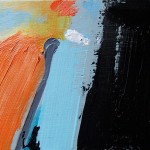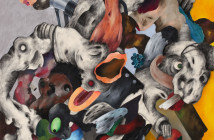In Provincetown, there is a great deal of what no longer is. Who sits in the poet Stanley Kunitz's garden now, or writes in Norman Mailer's house? And even in October, the hulking tourist buses angle and reverse at the compact intersections. I was not looking for a subject when I arrived, having long had the sense that you could carry a painting from one gallery to the next here, replacing it at each stop with another, and no one would ever notice the alteration, so absolute is the single currency of opaque sunsets and dim sand.
But there were lessons waiting for my arrogance.
The first was not entirely a surprise. It has been some two years now that I have known and been lifted up by Emilia's Dubicki's painting. I have recently reviewed it elsewhere, but I wanted to also declare my approval to a person in Provincetown who shared it.
So I made my way down an alley to the Julie Heller Gallery to encounter its exquisite clutter for the first time. There are spaces full of choices where you immediately register the unerring confidence of the one who made them, even when not every detail is visible. Nothing was random in this accumulation, the frames standing in ranks ten or twelve deep along the floor. There was cadmium, a panel by Dubicki, its small brightness in conversation with the mad, wondrous lurching of a Hans Hoffmann print on the adjoining wall. And I realized that there was not a piece here that was not worth looking at, each one marked by the owner's clarity in connecting past and present.
This was the thread I followed to the exhibition Search for the Real (now closed) at the Provincetown Art Association and Museumwhere drawings by Hans Hoffmann were gathered alongside those of his students, the teacher's commentary like ornaments dangling from the limbs of the apprentice figures. Here was an illustrated catalogue of inheritance and resistance. For me, this latter quality was particularly clear in a work by Stephen Pace, an artist I had not before known, with a slashing, transfixed figure that had no need for the tutor's marks.
In an adjoining space, like a parallel world, photographs by Paula Horn Kotis (until November 15), documenting the places of ordinary exile, whether of several women, exhausted, in a museum, or one collapsed on a restaurant counter. I can't imagine that Diane Arbus knew her work. If she had seen the humanity there, she might have survived.
My last lesson was at The Shell Shop, with its sequestered heaps of those skeletons that some sea creatures wear. I had recently seen an exhibition of 18th century British curiosities at Yale entitled Mrs. Delany and Her Circle, and had been much taken with a specimen of coral that resembled a loaf composed of thinly sliced bone, or the spine of a larger slug (if a slug possessed one). In any case, I inquired of the shopkeeper as to whether she might have one of these resplendent artifacts. Indeed, she did. But I had a daughter nearby of conscience enough to warn me that what were once the small depredations practiced by the early naturalists of imperialism had now become major ecological disasters which I would be encouraging with such a purchase. Thus, a reminder that art is a disguise, often enough, for a crime.
- Emilia Dubicki, cadmium, 2009, oil on board. Courtesy of the artist.
- Paula Horn Kotis, Woman Asleep at Table, New York, 1950’s. Courtesy of The Schoolhouse Gallery.
Julie Heller Gallery
Provincetown Art Association and Museum
"Paula Horn Kotis: Photographs" is on view until November 15, and "Search for the Real" was on view until October 11th at the Provincetown Art Association and Museum, located at 460 Commercial Street, Provincetown, MA.






